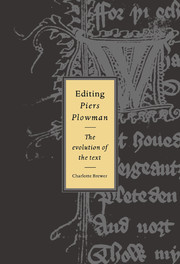Book contents
- Frontmatter
- Contents
- Acknowledgements
- Abbreviations
- Note on the texts
- Introduction
- Part I The early phase
- Part II The late nineteenth century
- 5 The Early English Text Society and its editorial context
- 6 Skeat: introduction
- 7 Skeat's A-Text
- 8 Skeat's B-Text
- 9 Skeat's C-Text
- Part III The Skeat aftermath
- Part IV Chambers and Grattan, Knott and Fowler
- Part V The Athlone Press edition
- Part VI Epilogue: the Athlone aftermath: Schmidt, Pearsall, Rigg-Brewer, et al.
- Works cited
- General index
- Index of manuscripts
- CAMBRIDGE STUDIES IN MEDIEVAL LITERATURE
7 - Skeat's A-Text
Published online by Cambridge University Press: 20 August 2009
- Frontmatter
- Contents
- Acknowledgements
- Abbreviations
- Note on the texts
- Introduction
- Part I The early phase
- Part II The late nineteenth century
- 5 The Early English Text Society and its editorial context
- 6 Skeat: introduction
- 7 Skeat's A-Text
- 8 Skeat's B-Text
- 9 Skeat's C-Text
- Part III The Skeat aftermath
- Part IV Chambers and Grattan, Knott and Fowler
- Part V The Athlone Press edition
- Part VI Epilogue: the Athlone aftermath: Schmidt, Pearsall, Rigg-Brewer, et al.
- Works cited
- General index
- Index of manuscripts
- CAMBRIDGE STUDIES IN MEDIEVAL LITERATURE
Summary
By the time his A-Text was published the following year, in 1867, Skeat had made considerable advances in his understanding of the manuscript relations and his hypotheses about the original versions they might be supposed to represent. But he begins with a more popular introductory section attempting to answer the question, ‘What is Piers Plowman?’ ‘A poet of the reign of Edward the Third’, comes the reply, ‘of whom scarcely anything is known but the name (and even that is uncertain), wrote a poem in alliterative verse which he threw into the form of several successive visions; in one of these he describes his favourite ideal character – Piers – and in course of time the name was used as a common title for the whole series of them.’ Langland's ‘vivid descriptions and earnest language’, Skeat continues, ‘caused the poem to be very popular, and the fertile imagination of the author induced him to rewrite the poem twice over, so that what may fairly be called three versions of it exist in manuscript’. Skeat notes that ‘the vivid truthfulness of its delineations of the life and manners of our forefathers has often been praised, and it is difficult to praise it too highly’, and he stresses its historical value: ‘As indicating the true temper and feelings of the English mind in the fourteenth century, it is worth volumes of history.’
- Type
- Chapter
- Information
- Editing Piers PlowmanThe Evolution of the Text, pp. 113 - 136Publisher: Cambridge University PressPrint publication year: 1996

